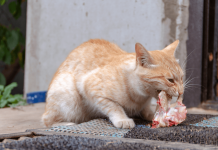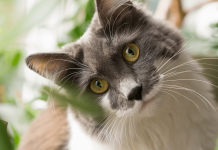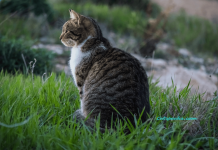I bet you have seen your cats purring many times. But have you ever been curious about why they purr? Or how do cats purr? Well, the total meaning of a cat’s purr is still a mystery. Scientists have claimed some probable reasons why a cat purrs.
However, there is a clear concept of how the cats purr. The felines make the purring sound by using the muscles of the larynx. The muscles produce a vibration in the vocal folds, which comes out as a purring noise.
If you are a bit interested in the purring noise of a cat, then check this article. Here you will get everything on why a cat purrs or how he does it.
How Do Cats Purr?
The mechanism behind a cat’s purring is actually pretty easy. It involves two important things, the larynx muscles, and the diaphragm.
A cat’s brain sends a signal to the voice box for purring. This voice box is called laryngeal muscles. When a cat breathes in and out, the air hits the larynx muscles. The continuous contraction of the muscles produces a vibratory purring noise.
Let me explain the whole mechanism in simple words. Imagine there is special wiring that travels from the cat’s brain to the voice box. The wiring can vibrate the larynx or voice box muscles when air flows through them. That is how a purring sound is created.
How do cats purr continuously? Have you ever thought about that? Well, the larynx muscles can work both during inhalation and exhalation. And so, a cat can purr continuously if he wants.
Why do cats purr?

Now you know how a cat purrs. Are you excited to learn why he makes this noise? Well, you can not absolutely prove why a cat is purring, but there are some probable reasons. And most experts support those facts. Let’s discuss those, one by one.
1. A cat purrs when he is happy and relaxed. You will notice your cat purring when he is comfortable and enjoying your company.
He will purr lying on his back, keeping his eyes half-closed and tail still. This is the scene of a cat’s full contentment. A cat can also do purring noise on your lap. Try to pet him or stroke him at that time. It will make the cat more safe and comfortable.
2. A cat purrs if he is angry or stressed. But this purring is a bit different from the one the cat makes when he is happy. An angry purr comes with growling and hissing. If your cat is angry and purring, do not try to entertain or stroke him. Instead, leave him alone and give him some time to calm down.
3. How do cats communicate with each other? Have you ever thought about it? Purring is the way of communication among cats.
A kitten purrs after seeing it mom or when it needs to call the mother cat. If the kitten is away from the mom’s sight, it purrs continuously. However, a mother cat also purrs to her kitten to make it fall asleep. Consider this purring as a lullaby.
4. A cat can purr if it is sad. This purring sound is more heartbreaking and mournful. If your cat is purring in a sad voice, then something must have happened to him. Pet the feline and try to make him feel comfortable, relaxed, and happy.
5. Have you ever noticed the behavior of your cat when it is hungry? Yes, the pet purrs and begs for food. This purring sound is mixed with an unpleasant cry. You can compare it to the crying sound of a human baby. The cat also makes this sound if he wants something.
6. You cat purr when it gets hurt. So what makes this purring worthy. You will be surprised to know that purring has a healing capability.
This is just a way for the cat to soothe itself. Some experts have claimed that purring can help a cat to recover or heal faster. How? The low-frequency purr creates a vibration in the cat’s body, which helps the pet to recover.
Purring also helps heal bones and wounds, easing breath, repairing tendons, and lessening any body pain. A cat’s purr vibrates at 25 to 150 Hz. This frequency increases a cat’s bone density.
These are the most probable reasons why a cat purrs. But as I have said before, you can not tell for sure. Here is the most interesting part about purring. A cat owner, even a person who does not have a cat, can understand the cat’s mood from its purring.
Why do cats purr and knead?
You already know that most of the time, a cat purrs when he is happy and pleased. If your cat is purring and kneading simultaneously, it demonstrates that he is enjoying your company. The kneading is the way to return the affection you are giving him.
Generally, a cat kneads a soft surface like a pillow and blankets. If he is very happy, it may jump on your lap and start kneading. Sometimes, this type of kneading hurts as the cat will try digging deeper. Do not punish him for this. Instead, place a soft pillow between your lap and the cat.
Does the purring of a cat help humans?
Owning a cat is very healthy for anyone. It keeps the owner more relaxed and stress-free. But does the purring of a cat help its owner? It can be surprising, but the answer is yes.
Owning a cat can reduce the chances of having a heart attack by about 40%. Also, blood pressure stays in control. Many cat owners claim that their migraine pain reduces after hearing the purring voice of a cat.
How do cats purr, or why do cats purr? I hope you have got your answer. Try to respond to your cat when it is purring and pet him if needed.
Related: Why Do Cats Purr? – Learn The Truth Behind Your Pets Purring
Related: How Long Are Cats Pregnant? – Everything About The Cat’s Pregnancy






































